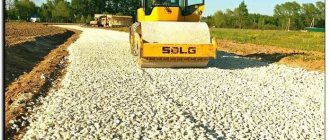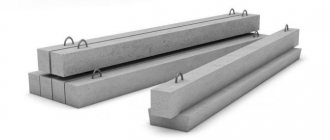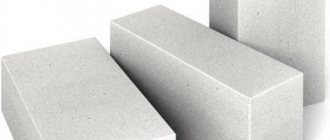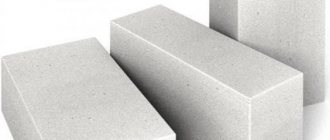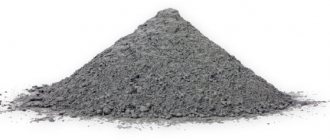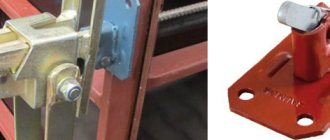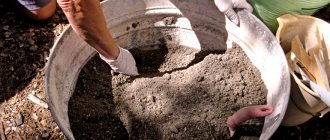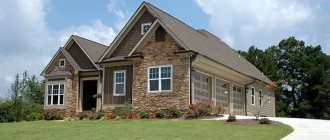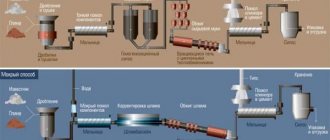What is polystyrene concrete - a cheap replacement for wood or a full-fledged material of the future?
In Russia, polystyrene concrete is not yet a popular building material. However, judging by the number of companies producing PSB, the demand for this type of lightweight concrete is growing.
Polystyrene concrete has a lot of advantages - heat and noise insulation properties, efficiency, biostability, low water absorption.
RECOMMENDED ON THE TOPIC
- Characteristics and application…
- Lego brick: what is it and...
What is polystyrene concrete
Polystyrene concrete is often classified as lightweight concrete. However, based on the density classification GOST 25192-2012 (figure below), this is not entirely true. Polystyrene concrete with a density of 150–600 kg/m3 (grades D150–D600) belongs to the class of extra light.
Therefore, there is no need to talk about competition between PSB and “ordinary” heavy concrete.
Polystyrene concrete consists of:
- binder - cement;
- filler – here (in contrast to heavy concrete) these are foamed polystyrene granules;
- plasticizer and water;
- microfoaming agent (air-entraining additive, VVD) - usually this is SDO (saponified wood resin).
Like ordinary concrete, polystyrene concrete is a composite. Cement and water are responsible for the formation of a plastic matrix. Polystyrene foam balls and SDO create a uniform porous structure that ensures strength.
It is worth saying in more detail about the function of SDO in lightweight concrete, the addition:
- speeds up the preparation of the solution;
- reduces density - the resin literally adds air to the material, additional pores appear in the concrete stone (picture below);
- increases the homogeneity of the structure with low sand and water content;
- simplifies the laying and compaction of the mixture, preventing stratification of the laid solution (floating of foam granules).
Additional components of polystyrene concrete include:
- additives to impart special properties - tar for hydrophobicity;
- quartz sand - for greater strength and rigidity.
The key difference between PSB and heavy concrete: sand is not a necessary (and not always desirable) component.
Taking into account the steadily rising prices for heating, polystyrene concrete is attractive due to its high thermal insulation ability with a wall thickness of only 30 cm.
When using the term “expanded polystyrene concrete” they may mean both PSB and a similar material with a smaller volume of granules (0.9 parts per cubic meter versus 1.1 for polystyrene concrete).
Expanded polystyrene concrete is primarily held together by air bubbles. From a technology point of view, PPSB is more difficult to manufacture. When choosing a material for construction, it is better to focus on the characteristics rather than the name.
How to calculate wall thickness
To calculate the required wall thickness you need to know:
- thermal characteristics of the material from which the structure will be built. If there are several materials - all materials.
- Degree-days of the heating period (GSOP) This parameter can be taken from a reference book or calculated using the formula GSOP = (tв - tо)zоt,
where tо, zоt is the average outdoor air temperature, °С, and the duration, days/year, of the heating period, tв is the estimated temperature of the building’s internal air, °С, according to GOST 30494. For Moscow and St. Petersburg, GSOP is equal to 6000
- Wall resistance to heat transfer. This is a reference value that depends on the GSOP; you can find out its value in SNiP 2-3-79. For residential buildings in Moscow this is 3.5 (m2? ° C)/W.
The calculation is carried out according to the formula R = s / ? (m2•°C/W), where R is the heat transfer resistance, s is the wall thickness (m), and ? — thermal conductivity. Based on this formula, we get S= R * ?. An example of calculating the wall thickness of a residential building made of D600 polystyrene concrete blocks in Moscow: S = 3.5*0.14=0.49 m, i.e. In order for the building to comply with SNiP 02/23/2003 “Thermal protection of buildings”, a polystyrene concrete wall almost half a meter thick is required. Red brick wall thickness should be S=3.5*0.56=1.96 m. These are calculations for dry material; with increasing humidity, the thermal conductivity coefficient also increases.
Due to its low hygroscopicity, it is allowed to operate structures made of polystyrene concrete without covering the facade.
Thinner walls not only allow you to save useful space inside the building, but also reduce the overall weight of the structure, thereby reducing the load on the foundation. Low-rise houses made of polystyrene concrete can be erected on shallow strip foundations and even on pile-screw foundations.
Relatively low weight with high thermal protection indicators allows the use of polystyrene concrete when adding additional floors or attics to already constructed buildings.
Use as insulation
From the point of view of thermal insulation, polystyrene concrete is an improved polystyrene foam - non-flammable, dense, suitable for roofing.
The properties of PSB grades from the point of view of thermal insulation are presented in the table:
Polystyrene concrete blocks are cast and not cut, like aerated concrete. As a result (especially for not the most responsible manufacturers), dimensional accuracy decreases. Thermal insulation benefits are offset by thick cement mortar seams that smooth out the unevenness of the block.
For external insulation, it is better to use thin PSB panels - they just need to be glued on top of the facade, plastered and painted.
Improved Thermal Performance
Such characteristics of polystyrene concrete as thermal conductivity and thermal resistance coefficient can be improved at the mortar production stage by increasing the amount or fraction of foamed polystyrene granules and accordingly changing the composition of the mixture. When making polystyrene concrete yourself on a construction site, for example for monolithic work, it is important to strictly follow the dosage. Even a slight change in composition can seriously change the strength and insulating properties of the material.
You cannot change the ratio of the mixture components or use materials with characteristics different from those calculated, for example, PC 400 cement instead of 500.
With increasing humidity and wetting of the material, the thermal insulation characteristics deteriorate significantly. Walls made of high-density polystyrene concrete can be additionally insulated using low-density polystyrene concrete or mineral wool.
Window and door lintels
These are the only warm lintels on the building materials market. However, there is an opinion that polystyrene concrete can only be laid on a brick pad to prevent chipping or cracking of the block under the lintel. The brick, in turn, plays the role of a cold bridge, minimizing the thermal insulation properties of the lintel.
This can happen in foam and aerated concrete houses. However, for aerated concrete, the technology of using a “belt” of u-blocks (troughs) with reinforcement, concrete pouring and insulation has been developed. The armored belt allows you to make even a wide opening reliable and warm.
In fact, there is definitely a risk only in 3 cases:
- it is planned to rest the floor slabs on the lintels;
- blocks that are too light or of poor quality are used for walls;
- window openings wider than 1.5 m.
Conclusion
The density of polystyrene concrete is not high compared to other analogues on the market, however, it is more than enough to build a high-quality house that will provide warmth for many years. The deficiency is compensated by other more than competitive indicators:
- Low moisture absorption;
- Weight of the final structure;
- High thermal conductivity values of polystyrene concrete, especially for products with low density.
Products made from polystyrene and cement are reasonably competitive, which allows them to be used in low-rise construction. Its performance is on par, and more often than not, higher than that of similar materials.
Do-it-yourself polystyrene concrete production
The first attempt to use polystyrene foam as a filler for concrete was made in 1951. However, by the standards of that time, the new material seemed low-profit due to:
- high cost of expanded polystyrene;
- low strength of the resulting concrete monolith.
At the time of the birth of PSB, panel and brick houses were in demand. They didn’t think about energy saving and “warm” technologies back then.
However, by the 1970s the situation had changed:
- research was carried out to reduce the cost of filler granules;
- The demand for energy-saving technologies has increased - Canada, the USA, Germany, and France have become fashion trendsetters for polystyrene concrete.
PS concrete can be ordered at the factory or prepared independently by purchasing or renting a concrete mixer.
Heavy concrete can be mixed with only a trough and a shovel on hand - many private developers poured volumetric foundations with such a solution; polystyrene concrete cannot be made without a mixer.
At home, thermal insulation grades are more often prepared, but you should start with a general recipe that is relevant for any type of PSB.
For different brands, the proportions will be different, an example is in the table below:
The recommendations from the following table suggest the use not of granules (PVG), but of crushed grains (products of crushing containers or polystyrene foam boards) - this is permitted by GOST for grades below D400:
To compensate for the loss of strength when using crushed grains, the volume of cement is increased.
GOST 2016 prohibits the introduction of construction sand into the composition. However, when using Portland cement above M400, it is allowed to “dilute” the binder with quartz sand in a 2:1 ratio. There are also ready-made tables for such recipes:
